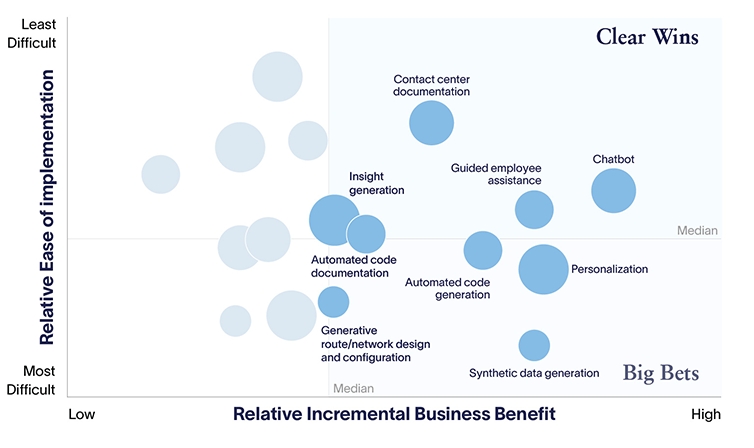In the ever-evolving telecommunications industry, continuous innovation is imperative to meet the demands of a digitally driven world. As technology paves the way for groundbreaking advancements, generative AI captures attention and interest across the telecom industry.
Generative models, including generative AI, are a subset of artificial intelligence distinguished by their ability to create new content based on a user’s prompt, from generating content to imitating human “chattiness” and producing quality pictures or videos.
The telecommunications sector presents one of the richest case studies of generative AI usage. The industry generates enormous volumes of rich data amid strict regulations on data protection requirements and looming obstacles from outdated technology systems. Since generative AI thrives on large datasets, the telecommunications sector is well-suited to process, interact, and derive insights from this data – creating a unique opportunity for exploration and implementation.
To assess the telecommunications sector’s sentiments on generative AI and understand the current and future adoption of this technology, Altman Solon worked with Amazon Web Services (AWS) to survey 100 senior business leaders at Tier 1 communication service providers headquartered in the U.S., Western Europe, and Asia Pacific. Additionally, Altman Solon drew on the experience of 25 industry experts through live, anonymized, in-depth interviews to understand the relevant use cases and top concerns regarding generative AI tools of global wireless, wireline, and cable companies.
Generative AI use cases for telecommunications: “clear wins” and “big bets”
To date, the early adopters among the communication service providers surveyed have embarked on plans to experiment, test, and explore the potential of generative AI across multiple business functions and use cases. A group likely to grow, survey findings show that CSPs anticipate a sustained increase in investments in generative AI. Those already adopting generative AI are allocating less than 1% of their total technology expenditure towards these capabilities. However, 45% of CSPs expect this spending on generative AI use cases to surge over the next two years, growing by as much as six times by scaling implementations and exploring new use cases.
Our study tested 17 use cases across four domains: Product & Marketing, Customer Service, IT, and Network. Certain use cases are poised for earlier implementation, promising immediate benefits, identified in the exhibit below as “Clear Wins.” In contrast, “Big Bet” use cases are firmly rooted in the longer-term horizon, requiring comprehensive planning and adaptation to fully realize their potential. The current adoption rate for the tested use cases averages around 19% globally; however, this is expected to increase significantly, to upwards of 48%, over the next two years.
Please rate each use case your organization is in the process of adopting by ease of implementation and incremental business benefit on a scale of 1 to 5.
CSPs are currently focusing their generative AI adoption on use cases that enhance customer-centricity and productivity. The survey shows one Clear Win use case leading the pack: customer chatbots are the most widely adopted use case, with 63% of respondents noting this as already in production. Other common use cases focus on employee assistance, including call center documentation and network operations knowledge management, each key drivers of operational efficiency.
Contrasting these uses, those within network planning and IT software development are slightly slower to adopt, bringing greater complexity to the implementation process. Within these areas, network root cause analysis, interfacing with network ML models, and software code documentation are use cases more likely to be adopted in the near term, while network planning and optimization have Inherent complexities that delay their likely adoption timelines.
Data governance, ownership could hinder telcos adopting generative AI
While the industry gravitates toward further integration of generative AI in the coming years, it faces several challenges. CSPs are generally optimistic about the potential for generative AI to create significant and incremental value for their organization, seeing the technology as a means to streamline processes, drive innovation, and unlock new sources of value. However, there is a sense among leaders that the near-term implementations could be limited in their transformative potential due to CSPs’ reliance on rule-based chatbots previously utilizing AI/ML technologies. In addition, telcos often seek high-performance models trained on their data for specific purposes, which can be resource-intensive and time-consuming. As such, it is crucial that the necessary data governance and ownership measures are in place when implementing generative AI solutions, which is often a gap and critical hurdle.
More data-capable CSPs leading in generative AI adoption share common characteristics at the organizational level. First, establishing a dedicated AI center of excellence enables CSPs to centralize their AI/ML departments, streamlining the evaluation and implementation of AI solutions. Second, integrating advanced analytics throughout the organization increases data accessibility and fuels data-driven decision-making. Lastly, a modern, cloud-based infrastructure establishes data architectures that can integrate data from disparate sources to meet the security and regulatory requirements inherent in handling sensitive data.
CSPs to customize generative AI models and deployment considerations
Upon deciding to implement generative AI, most CSPs surveyed expect to use off-the-shelf models rather than develop foundation models in-house, which only 15% of CSPs support. Of those using off-the-shelf models, over 65% plan on training their models primarily using their proprietary internal data. This reliance on internal data is aligned with CSPs’ objectives to customize pre-trained models and tailor them to handle industry-specific terms and contexts.
Please indicate the likely implementation method for generative AI models for the business domain(s) selected.
Best practices for deployment are still being debated as they pertain to costs and associated benefits. CSPs broadly consider two relatively different approaches for adapting large language models (LLMs) for specific tasks: fine-tuning and prompt engineering/context learning. While both paths are being explored by CSPs, context learning can present an attractive option for those looking to save on costs given low resource intensity.
Key considerations for telcos adopting generative AI solutions
Generative AI adoption within the telecommunications industry will continue to evolve dynamically over the coming years. Leaders should consider the following when integrating these solutions into their business:
- Telecommunications companies will be confronted with a multitude of technical and operational challenges when adopting generative AI. To succeed, telcos must review their data governance practices and ensure that data infrastructure supports compliance with data security, privacy, and sovereignty requirements.
- “Clear Win” use cases, such as customer chatbots and employee assistance, are ripe for implementation and can leverage off-the-shelf models with adjustments when adopting. “Big Bet” use cases – more transformative, high-value use cases, such as network planning and optimization, are of interest for telcos but require high-quality, sensitive data. Strong data governance practices will be imperative for CSPs preparing for these use cases.
- CSPs should explore various implementation and deployment options and be aware that the future of generative AI in the telecommunications space will be shaped by advancements in technology, including AI regulations and managed service platforms enabling customization of LLMs.
The fusion of generative AI and telecommunication is imperative. CSPs must embrace integrating generative AI throughout the fabric of their operations and prepare for a transformative journey by having a clear understanding of use cases, deployment paths, and data dependencies.
Altman Solon is helping leading telecommunications organizations navigate the adoption and integration of generative AI solutions. Through proprietary insights from over 100 senior business leaders at Tier 1 communication service providers in the U.S., Western Europe, and Asia Pacific, this report offers insight into generative AI adoption patterns, relevant use cases, and top concerns regarding generative AI in the telecom industry.
This report represents the independent perspectives of Altman Solon, although it was produced as part of a paid client engagement










